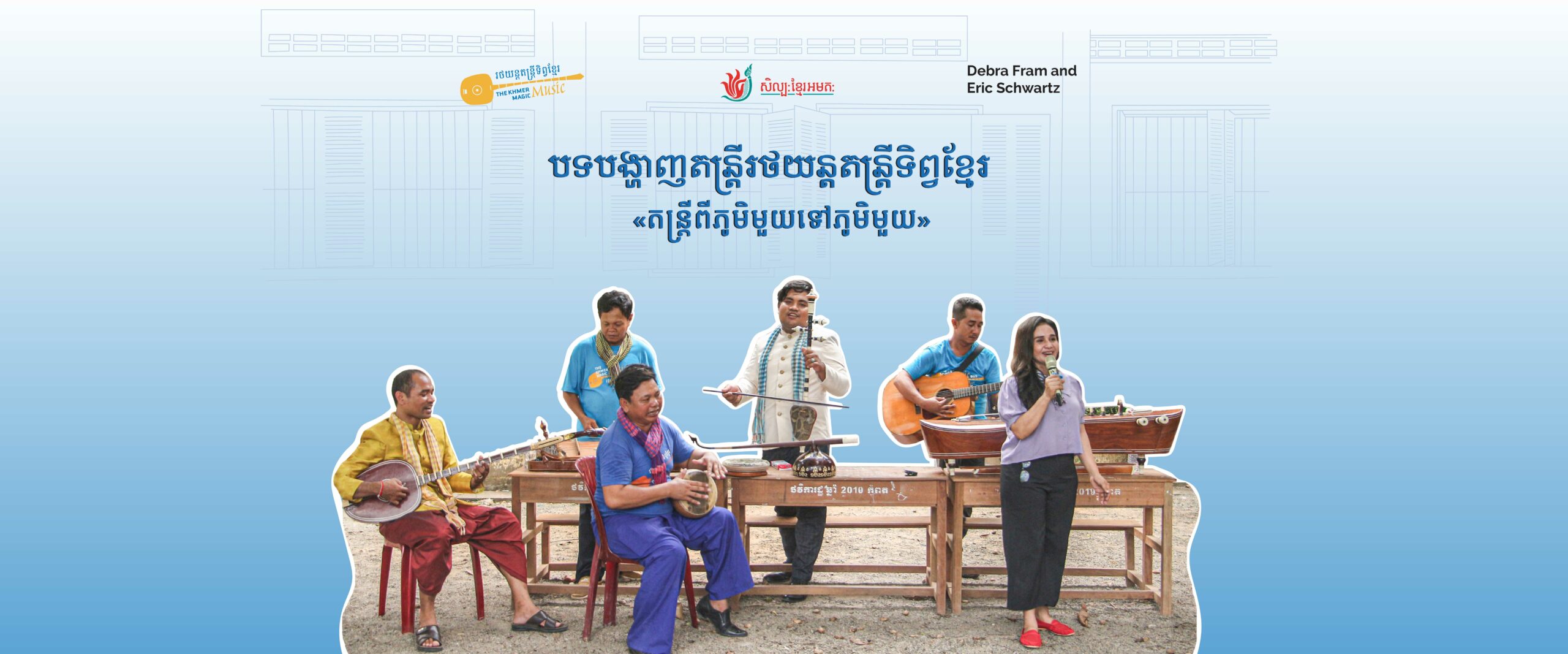After introducing rural communities to traditional Musical instruments, the Khmer Magic Music Bus initiative is expanding its reach to the capital, hosting events that aim to raise the profile of the traditional art form among the youth living in Phnom Penh city!
The Khmer Magic Music Bus (KMMB) programme was inspired by the misunderstanding surrounding Khmer traditional musical instruments among Cambodian youth in both rural and urban areas, triggering concerns about the loss of Khmer traditional arts.
A group of artists and art enthusiasts pursued launching the KMMB to raise awareness about arts and, hopefully, keep Cambodian young people engaged in preserving the endangered form of traditional music
History of Khmer Magic Music Bus
The idea for KMMB was initially sparked in 2013, when its founders noticed every year American students visiting Cambodia by bus, but there was an absence of cultural showcasing for these students.
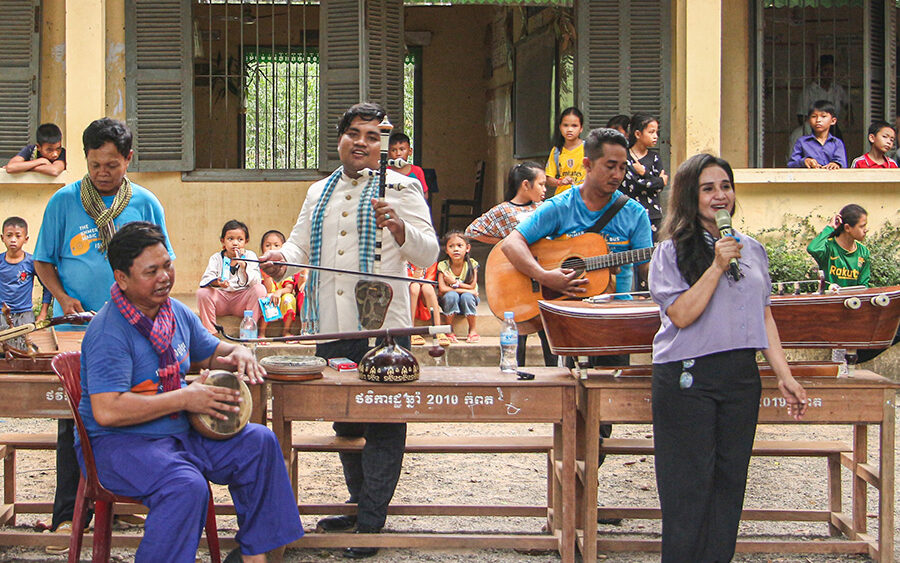
Therefore, instead of wasting time travelling hours by bus to distant provinces without any activities, they decided to bring Khmer musicians to play traditional music instruments, with the aim of introducing the art form to the students.
Thorn Seyma, Community Engagement & Outreach Coordinator, said the bus features traditional instruments and a guitar to allow artists and international students to play music together during their travels. Sometimes, workshops are also held on the bus.
In 2017, the KMMB joined CLA and became a project under the program of Community Engagement and Outreach with the goals to engage with people who have limited access to arts opportunities and experiences, particularly those in rural areas. This is accomplished through village concerts and tours conducted throughout the year, Community Arts Demonstrations, and on-site presentations.
Lack of National Arts Activities Motivates KMMB to Thrive
One day after returning from performing in a music show on the bus at Oddar Meanchey province, Seyma and her team realised that it is not only foreign students and teachers who do not know about Khmer musical instruments, but also Cambodians.
“Most of the musical instruments were not recognised when we first introduced them to them [Cambodian citizens in rural areas] in early 2013. I felt so upset since those instruments are all ours but we don’t know anything about them,” Seyma said about her upset over Khmer musical instruments not being recognised well by her own people.
“They called the Chapey the Tror (two-stringed fiddle), and think Tror is Sadeav,” she said with a heavy breath. “At that time, it pushed us to bring these musical instruments to let people living in remote communities get to know more.”
Despite the rural Cambodian’s lack of knowledge about Khmer musical instruments, they also have a gap in understanding what Khmer musical instruments are. This motivated the KMMB and the CLA team to organise Music Demos regularly.
Then, there were no set dates for the KMMB event, or the target bus stops or how many days it would take place for. This set the CLA team on a mission to find remote schools and communities who have never seen or heard Khmer traditional music.
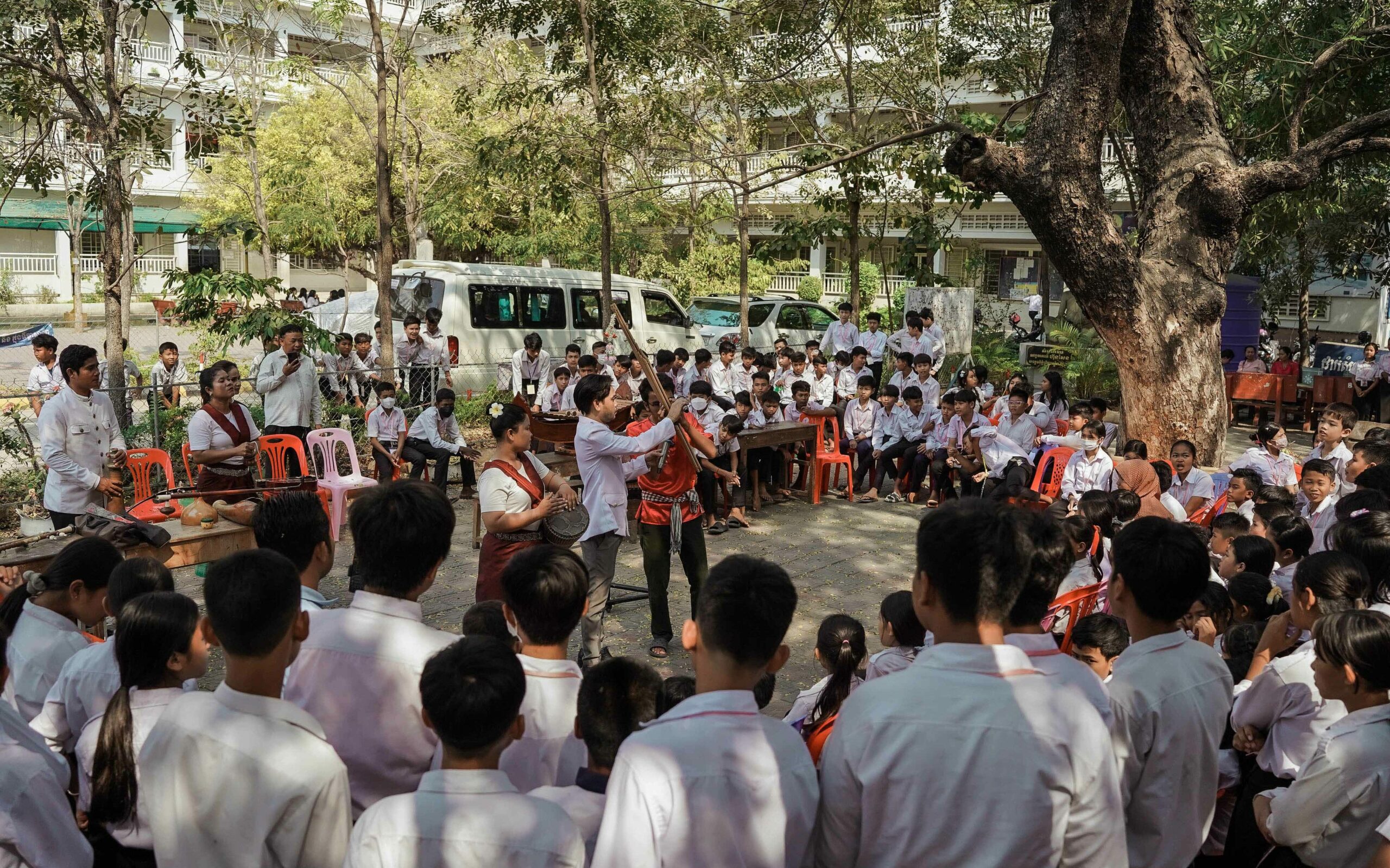
Music Brings Back Lost Happiness Memories to Alive
“They cried because they said it [music] reminds them about the moments they were with their family before the Pol Pot regime. Before they used to visit music shows with their family and now they are alone,” Seyma said, recapping villagers’ expressions when they first listened to the music show.
After the war, many no longer have the capacity to travel to towns to watch shows, so they rarely see cultural or art performances like previously.
The reason it is named KMMB is because the music that plays in the provinces can heal people from sadness and help them to recall happy memories with their beloved people before the war.
“Music is the same as a magic pill because whenever we stop and play the music, it makes people feel better, which cures their feelings, so we decided to call this programme KMMB,” Seyma said.
Sometimes, villagers ask the KMMB team to travel from one province to another while enjoying dancing and singing Khmer music along the way, Seyma said, recapping happy moments with villagers while organising KMMB across Cambodia.
A Gap of Khmer Music Knowledge in Urban Areas
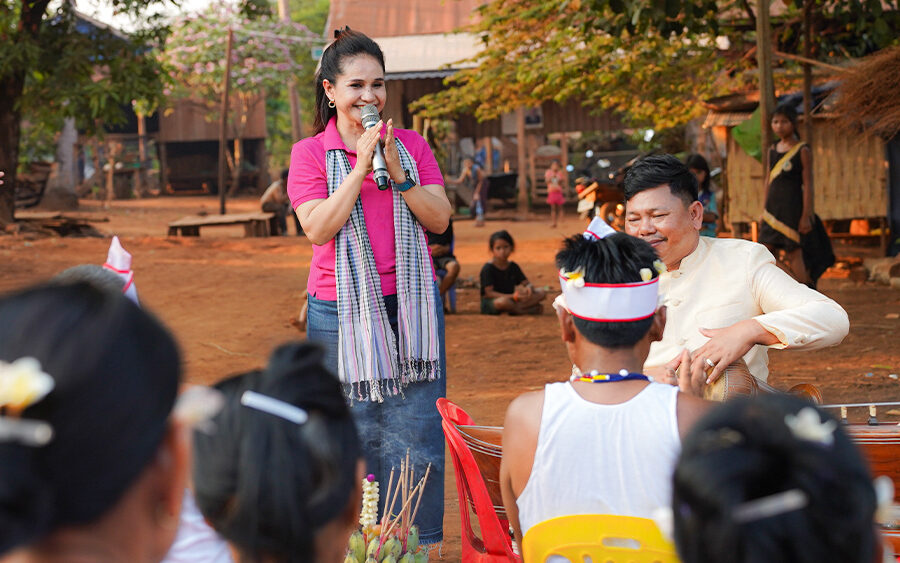
One day, Seyma conducted a music demo at a public school in Ta Khmao, near Phnom Penh City. She realised that even students living in urban areas lacked knowledge about Khmer traditional musical instruments, despite the numerous media platforms providing information about them.
“We want people who live in the city to feel like they are living in one community. In addition, we want the people in the city to get to know more about Khmer music instruments,” she said.
Reviving Interest in Khmer Traditional Music
Seyma encourages the next generation, especially youth, to learn more about Khmer musical instruments, while those who already possess knowledge should share it with friends and family members.
“Now we can see some young people already participating and know about Khmer musical instruments, and I hope they continue to study more. Because youth is the successor of bamboo, I encourage them to foster their learning more and share with their friends and family to learn about it to make Khmer music art more popular and widespread,” Seyma suggested.
As a senior artist in the field and someone who loves to sing Khmer traditional songs and be part of KMMB, Seyma also raised grave concerns over the misunderstanding of the names of these instruments, as well as the fact that Khmer traditional music seems less likely popular among Cambodian youth compared to the modern instruments.
“It is such a huge concern, that’s why we have to go to the countryside [to introduce Khmer traditional music instruments] once every two months, otherwise, we might lose our musical instruments,” she said.
“We are not only concerned about losing it [music instruments]; furthermore, we are afraid that nowadays youths don’t like to play Khmer instruments. That’s why we always want to inspire them to see the value of Khmer music, which will encourage them to pursue learning about it.”
Seyma noted that the dwindling interest in Khmer musical instruments among youth stems from a lack of market for them to earn enough income to support their family.
“Playing traditional Khmer musical instruments is not able to provide enough money to support their livelihoods and they don’t want to learn it. This is the main reason,” she explained.
However, the only way to plant the seeds of loving Khmer traditional music is to organise musical events as much as possible nationwide, giving youth, and others, the opportunity to absorb knowledge and understand its value.
KMMB Lights Up Engagement in Music

Yon Sokhorn, CLA Programs Director who has been working at the organisation for 12 years, said the bi-monthly programming is part of CLA’s ‘Community Arts Demonstrations’ program organised by the KMMB team.
“It is the first time that CLA has brought such a program to the city; it has previously only been presented in remote areas or provinces by the KMMB,” she said.
The KMMB Monthly Music Demo, is a bi-monthly program where Cambodian artists will present different genres of music, as well as other art forms, that allow the public, especially young people, to engage in art activities.
“I think it’s a good opportunity for various audiences, including art students, the general public, and researchers, to be exposed to these art forms and even engage in dialogue with the artists, most of whom are from provinces,” she said.
“It’s not meant to compete with other programmes in Phnom Penh, but rather to add diversity to existing ones and provide opportunities for these artists to reach new audiences. Additionally, there is a demand for art spaces to present these public programmes, so we would like to activate the CLA space as one of the safe and inclusive spaces for artists and audiences to connect.”
Sokhorn and the CLA team welcome other programs to showcase their works in their space if they believe it would be impactful and suitable to do so. The space can accommodate up to 80 audience members.
The two-hour programme usually takes place in the evening or at weekends to accommodate, for instance, students and families, allowing them to spend time together. About 40 people attended the first presentation of ‘Skor Pok Music’ on February 29.
“We observed that the majority of the audience during this initial demonstration were students from the Royal University of Fine Arts who came to learn about the art form. We are pleased that our programming can also serve the educational needs of students,” she said.
As this was the first time hosting the event in the CLA space, Sokhorn said she is not yet able to measure the impact at this early stage.
“Therefore, there is a learning curve for us. Previously, we had a bus, but it’s no longer available due to different priorities of the work.”
However, the program aims to provide Phnom Penh residents with the opportunity to experience various genres of music, including some that are rare or endangered. The chance for artists to share their stories is another crucial aspect of this bi-monthly programming.
“Traditional arts, as well as any art forms, are not static objects; they are dynamic, evolving elements of daily life and the present world, infused with ideas and meaning,” the Programs Director said.
“When people recognise this intrinsic value of the arts, mutual understanding flourishes, fostering appreciation for differences rather than appropriation, and ultimately leading to harmony.”
Experience Khmer Musical Instruments
Tha Sreynuth, 33, who works at the Embassy of Japan in Cambodia as a specialist in the Culture and Information Section, took part in the KMMB Monthly Music Demo in the City performance, Skor Pork (Pork Drum), at the CLA office in Phnom Penh for the first time.
“It was interesting. First of all, when I saw the announcement on the Facebook page of CLA, I wondered what Skor Pork is. Then when I attended to see and listen to the drum, it was more interesting and our Khmer music arts are creative,” she expressed.

Sreynuth believes that besides keeping up the conservation of Khmer traditional musical instruments, it is also important to keep the music up-to-date for the new generation.
“I think we protect the traditional one, but we need to update our culture following the young generation too. At this event, they allowed the audience to touch and play the instruments too. I also played, it was wonderful,” she recalled.
“If I didn’t join this event, maybe I wouldn’t know what Skor Pork is. It is not deeply understood, but at least we know some Khmer music instruments,” she added
Her last key message, “Sometimes we can spend time scrolling on our phone, YouTube or Facebook. Why not spend a little time to see the liveliness of our Khmer Art performance or cultural activities?”
CLA is Transforming its Space into a Creative Community Space
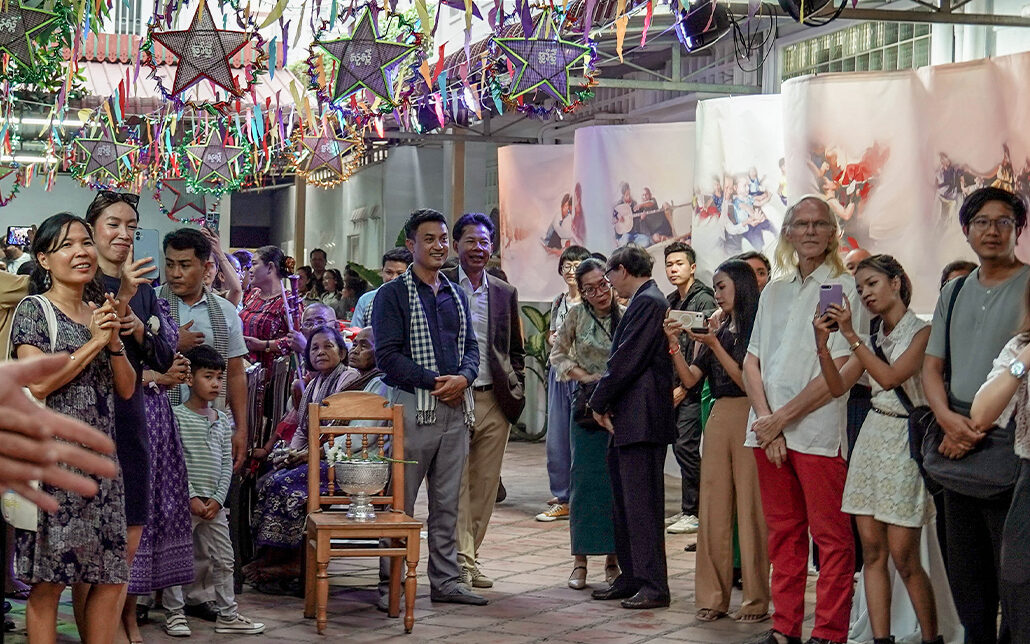
The KMMB Bi-monthly Music Demo is part of our initiative to foster engagement among artists, the arts community, the public, and especially youth. At CLA, we celebrate diversity and inclusion, value everyone’s voice, and aim for an environment where everyone feels supported, respected, and empowered.
In line with these goals, we’re excited to collaborate with Creative Generation to develop the Connected Canopy, a unique blend of art, architecture, and community at CLA’s space. It will provide a welcoming, safe, and inclusive venue for our arts community to host regular creative events, including CLA’s own programs such as talks, exhibitions, performances, film screenings, and readings.
We believe this will cater to a wide range of artistic disciplines and generations, from master artists to young creatives, and from traditional to contemporary arts. The Connected Canopy is set to be officially presented to the community by January 2025. Stay tuned for more updates!
